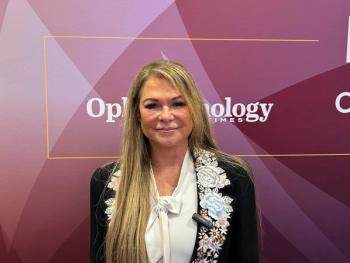
PRK enhancement after SMILE favorable after short follow-up
Surface ablation performed with mitomycin-C (MMC) seems to be a safe and effective technique for treating residual refractive error after myopic SMILE, said Martin Dirisamer, MD.
Surface ablation performed with mitomycin-C (MMC) seems to be a safe and effective technique for treating residual refractive error after myopic SMILE, said Martin Dirisamer, MD.
Dr. Dirisamer’s conclusion was based on findings from a retrospective study that included 40 eyes followed for 3 months after undergoing PRK as an enhancement
He noted that significant reduction in MRSE was achieved within 1 week after PRK, and the achieved MRSE was stable to month 3. Uncorrected visual acuity (UCVA) was significantly improved by the 6-week visit and remained stable through the available follow-up.
At 3 months, mean MRSE was 0.03 ± 0.57 D and mean UCVA was 0.08 ± 0.15 logMAR. There were two cases of significant overcorrection and two cases of significant undercorrection.
Beginning at 6 weeks postPRK, mean corrected distance visual acuity (CDVA) was equal to the pre-enhancement level. The procedure had a safety index of 1.06.
Six eyes (15%) lost 1 line of CDVA, but even in those eyes, CDVA at 3 months was 20/20 or 20/25.
“Of course long-term results are necessary to evaluate the efficacy and safety of surface ablation as a touch-up technique,” said Dr. Dirisamer, cornea consultant, Ludwig-Maximilians-University of Munich, Germany, and co-owner SMILE EYES Clinic, Linz, Austria.
“And, it is also necessary to compare outcomes using different enhancement techniques,” he added.
Why surface ablation?
Dr. Dirisamer noted that in addition to PRK, the options for treating residual refractive error after myopic SMILE include repeating SMILE or performing thin flap femto-LASIK or a CIRCLE procedure, which involves converting the SMILE cap into a flap.
“There are no reliable data on repeating SMILE, and re-SMILE is not recommended by the manufacturer,” Dr. Dirisamer said. “With either femto-LASIK or CIRCLE, the patient no longer has the advantage of having a flap-free procedure.
“PRK has known disadvantages, which include pain and slow visual rehabilitation, which would be even slower for an enhancement than after a primary PRK,” he said. “However, we chose PRK because we thought it would be the easiest to perform.”
The study included data collected at three laser centers located in Austria and Germany. Dr. Dirisamer noted that of 1,963 eyes that underwent myopic LASIK at these sites, 43 eyes (2.2%) of 31 patients had a PRK re-treatment.
For the 40 eyes that were included in the analysis, mean MRSE before SMILE was -6.35 D and mean MRSE before PRK was -0.86 D. All SMILE procedures were done with a standard protocol.
Mean time from SMILE to PRK was about 10 months. PRK was performed using the MEL 80 or MEL 90 excimer laser (Carl Zeiss Meditec) with one of four different ablation profiles: Advanced Ablation Algorithm (Triple-A, 67.5%), Tissue Saving Algorithm (TSA, 20%), topography guided (7.5%), or Aberration Smart Ablation (ASA, 5.0%). MMC 0.02% was applied for 20 to 25 seconds. The PRK target was for plano in all cases.
Understanding the outliers
MRSE outcomes in the two cases with a major undercorrection were -1.75 D and -0.88 D, respectively.
“The patient in our series who was left with the largest undercorrection had the highest refractive error before SMILE (~-10 D), and the PRK enhancement was done just 4 months after the SMILE, which may have been too soon,” Dr. Dirisamer said. “The other patient with a major undercorrection also had enhancement early, at 4.2 months after SMILE.”
MRSE at 3 months in the two overcorrected eyes was +1.75 D and +1.38 D, respectively. In both cases, PRK was performed using the ASA profile.
“The ASA profile is a fixed aspheric correction independent of the amount of myopia correction and leads to overcorrection in eyes with low MRSE,” Dr. Dirisamer said.
“Before this study was done, there were no data available to guide which PRK profile might be best,” he said. “Now we know at least that the ASA profile is not recommended.”
Two eyes developed significant haze after PRK that was treated successfully with topical corticosteroids. Dr. Dirisamer noted these eyes were not among the eyes with loss of CDVA.
“Perhaps the rate of CDVA loss in this series will decrease with longer follow-up,” he said.
Dr. Dirisamer receives grant support from Carl Zeiss Meditec.
Newsletter
Don’t miss out—get Ophthalmology Times updates on the latest clinical advancements and expert interviews, straight to your inbox.



















































.png)


